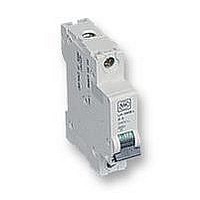5916S MK (ELECTRIC), 5916S Datasheet - Page 2

5916S
Manufacturer Part Number
5916S
Description
CIRCUIT BREAKER, 16A
Manufacturer
MK (ELECTRIC)
Series
SENTRYr
Datasheet
1.5906S.pdf
(3 pages)
Specifications of 5916S
No. Of Poles
1
Voltage Rating Vac
240V
Mounting Type
DIN Rail
Svhc
No SVHC (18-Jun-2010)
Approval Bodies
BS EN60898, IEE
Breaking Capacity Current Ac
6kA
Breaking Capacity Current Dc
6kA
Current Rating
16A
TECHNICAL DATA SHEET
Sentry
Miniature Circuit Breakers
2:3
©2002 MK Electric Limited The Arnold Centre, Paycocke Road, Basildon, Essex SS14 3EA, United Kingdom Tel: +44 (0)1268 563720 Fax: +44 (0)1268 563064 email: more@mkelectric.co.uk www.mkelectric.co.uk
TECHNICAL SPECIFICATION
Electrical
Voltage rating:
250V/415V a.c.
Operating frequency:
50Hz
Rated short circuit capacity Icn:
6000A
Service short circuit capacity Ics:
6000A
Energy limiting class:
Physical
Ambient operating temperature:
–25°C to +60°C
Calibration temperature +30°C
IP rating:
Front face IP4X, screw IP2X
Max. installation altitude:
2000 metres
3
Type C devices are capable of supplying the
majority of inductive and capacitive loads
such as motors, transformers and tungsten
or fluorescent lighting.
Time/Current
characteristics of Sentry MCBs are shown
graphically on the Time current characteristics
chart (See separate document).
Features
I
I
I
Installation
Selection of the most suitable MCB should take
into account the following considerations:
1. Operating voltage and frequencies
It is possible to use the Sentry MCB on other
voltages than 240/415V a.c. 50Hz, but it
should be noted that this takes the MCB
outside the scope of BS EN 60898.
2. Type of load
RESISTIVE
No derating is required in the case of resistive
loads.
INDUCTIVE
In the case of inductive loads from direct-on-
line motors, the surge on energisation can
produce up to 9 times full load current,
which may be present for several seconds. It
is therefore recommended that Type C MCBs
are used for such circuits.
When using assisted start motors, the usually
quoted figures are 2.5 times the full load
current, for periods generally longer than
those for direct-on-line starters. It is thus
important to establish the degree of inrush
current in order to select a suitable MCB. In
all instances, reference should be made to
both the motor manufacturer’s curves and
MK’s circuit breaker curves in order to select
the compatible miniature circuit breaker.
CAPACITIVE
Surges on energisation, for example with dis-
charge lighting, may well reach 25 times the
rated current of the device, but only for very
short duration. Type B devices will often be
adequate, but for more specialised circuits, a
Type C may be required. The lighting fitting
manufacturer’s recommendations should
be observed.
Meet BS EN and IEE Wiring Regulation
requirements
‘Trip-free’ mechanism
Positive contact status indication
and
Energy
let
through
I
I
I
TYPE D
(not offered in the Sentry Range)
The Type D MCB is suitable for applications
involving equipment generating very high
inrush currents, e.g. x-ray equipment, trans-
mitters and computer power supplies. The
magnetic operating limits are between 10 and
20 times the current rating of the MCB.
3. Fault breaking capacity
All Sentry MCBs have a short circuit breaking
capacity of 6,000A (M6).
For applications where the prospective fault
current is in excess of this, a BS 88, 100A
(maximum) fuse should be used upstream of
the MCB to provide a system breaking
capacity of 20,000A.
4. Discrimination with HRC fuses
A Sentry MCB consumer unit will normally be
supplied via an HRC fuse. The HRC in such
instances will be the major device and remain
unaffected by any fault current which causes
the MCB to operate.
The level of fault current up to which this can
be assured is determined by comparing the I
characteristics of the two devices. Discrimi-
nation will theoretically occur up to the level at
which the value of the total operating I
MCB is below the minimum pre-arcing I
the fuse, although in practice, discrimination
will be achieved at higher levels than this.
5. Cable protection
The current carrying capacity of the cable
should always exceed the current rating of the
MCB to prevent damage.
However, should this not be the case, a further
calculation may show that the MCB can still
interrupt the current in a sufficiently short time
to prevent overheating of the cable insulation.
Although this will prevent mechanical damage
to the cables, further overload protection
should be provided by a separate device, e.g.
a motor overload relay.
In case of doubt please contact the MK Tech-
nical Sales and Service Department.
Tunnel type, touch-proof, captive
terminals
Generous terminal capacity
Can be used as single pole isolating
switch
Edition 09-02
2
t of the
2
t of
2
t









